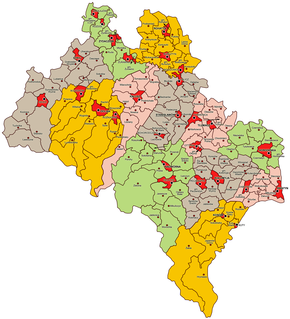Stanisławów Voivodeship (Polish: Województwo stanisławowskie) was an administrative district of the interwar Poland (1920–1939). It was established in December 1920 with an administrative center in Stanisławów. The voivodeship had an area of 16,900 km2 and comprised twelve counties (powiaty). Following World War II, at the insistence of Joseph Stalin during the Tehran Conference of 1943, Poland's borders were redrawn, Polish population forcibly resettled and Stanisławów Voivodeship was incorporated into the Ukrainian Soviet Socialist Republic as Stanislav Oblast (later renamed as Ivano-Frankivsk Oblast).
Following German invasion on Poland, and in accordance with the secret protocol of Molotov–Ribbentrop Pact, Soviet forces invaded eastern Poland on September 17, 1939. As bulk of the Polish Army was concentrated in the west, fighting Germans, the Soviets met with little resistance and their troops quickly moved westwards. Polish authorities originally intended to organize anti-German resistance in Stanisławów Voivodeship (see: Romanian Bridgehead), with Polish Army units planning to stand ground until the spring of 1940 when a French attack on Germany was expected. However, the Soviet invasion of Poland rendered these plans ineffectual. It is estimated that prior to Soviet counter-offensive in the latter part of World War II, over 18,000 Polish civilians in Stanisławów Voivodeship fell victims to OUN-UPA massacres.[1][2]
The Voivodeship's capital was Stanisławów (now Ivano-Frankivsk in Ukraine). In 1921 was inhabited by 1,339,191 people, and its population density was 72.9 persons per km2. Ukrainians and Ruthenians constituted 70% of the population, especially in the countryside. Poles, distributed across the entire voivodeship, made around 22%, Polish Jews (mainly in towns), around 7%. Also, there were smaller communities of Galician Germans. In 1931 the population grew to 1,480,285 and the density to 88 persons per km2.
According to the census of 1921 the Stanisławów Voivodeship was inhabited by 1,339,191 people, of whom by nationality 70.2% were Ruthenian (Ukrainian), 21.8% were Polish, 6.8% were Jewish, 1.1% were German and 0.1% all others. By religion 74.3% were Uniate or Orthodox, 14.3% were Roman Catholic, 0.8% were Protestant and 10.6% were Jewish.[3]
In 1931 the voivodeship had 1,480,285 inhabitants, of whom by mother tongue 68.8% spoke Ukrainian and Ruthenian, 22.4% spoke Polish, 7.4% spoke Yiddish and Hebrew, 1.1% spoke German and 0.3% spoke other languages. By religion 73% were Greek Catholic and Orthodox, 16.6% were Roman Catholic, 0.8% were Protestant, 9.4% were Jewish and 0.2% were others.
The results of the 1931 census (questions about mother tongue and about religion) are presented in the table below:
The Stanisławów Voivodeship's area was 16,894 square kilometers. It was located in south-eastern corner of the country, bordering Tarnopol Voivodeship to the northeast, Lwów Voivodeship to the west, Czechoslovakia (Between 1919 and 1938), Hungary (Between 1938 and 1939) and Romania to the south. It was in large part covered by forests of the Carpathian Mountains, with numerous mountain spas (Worochta, Skole, Dolina, Żabie, Sławsko, Woronienka, Jaremcza, Kuty). The landscape was hilly (in the north) and mountainous (in the south), with Hoverla in the Chornohora range as the highest peak (2060 meters above sea level). The other significant mountain range was the Gorgany.
The main river was the Dniester, which also marked border with the Tarnopol Voivodeship. Other rivers were: the Prut, the Stryj and the Cheremosh (the last one was at the same time bordering Poland from Romania).
Before the onset of World War II the Stanisławów Voivodeship consisted of 15 powiats (counties) (earlier 12), 29 towns, 904 villages and numerous smaller communities (futory, kolonie). Those were the same 12 powiats that were part of the Kingdom of Galicia and Lodomeria with the addition of Turka powiat later on. Its capital Stanisławów was the largest city, with population of some 60,000 (as of 1931). Other important municipal centers of the voivodeship were: Kołomyja (pop. 33,800), Stryj (pop. 30,500), Horodenka (pop. 12,200), Kalusz (pop. 12,100), Sniatyn (pop. 10,800) and Bolechow (pop. 10,700).
.jpg/440px-Stanisławów_Voivodeship_1939_Poland_(Województwo_Stanisławowskie).jpg)
The Stanisławów Voivodeship consisted of 12 powiats (counties):
The Stanisławów Voivodeship was located in the so-called Poland "B" region, which meant that it was underdeveloped, with low level of industry and considerable numbers of inhabitants living in poverty. Agricultural production was low due to poor quality of soil. Since mid-1930s, the area was quickly gaining popularity as a tourist destination, with numbers of visitors to mountain springs rising steadily year by year. Railroad network was well-developed in the north, with such important junctions as Stanisławów, Kołomyja and Stryj. In the south, however, rail connections were lacking.
On January 1, 1938, total length of railroads within Voivodeship's boundaries was 755 kilometers (4.5 km. per 100 km2).


The local government of voivodeship and city was located at address Ulica Karpinskiego, 7 (today - vulytsia Halytska, 2).
Following Soviet invasion of Poland on 17 September 1939, the voivodeship existed until 27 November 1939. On 6 October 1939 – 27 November 1939 the voivodeship was governed by Soviet provisional chairman of Civilian Administration Mikhail Grulenko who later continued to hold his post as the 1st secretary of the CPU in the region.
48°55′24″N 24°42′37″E / 48.923379°N 24.710144°E / 48.923379; 24.710144